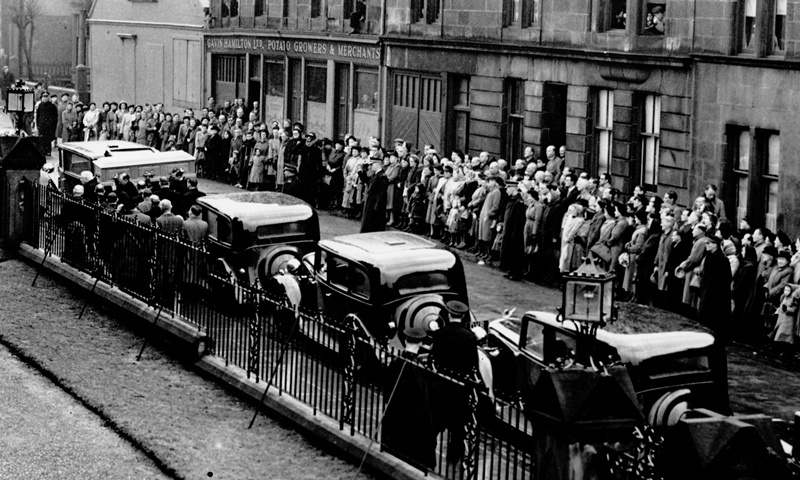On his deathbed, Sir Harry Lauder was in possession of an Abyssinian gold watch.
It was the first recognition of his talent and the object which marked the beginning of a showbusiness career which would lead him to superstardom.
The watch had been presented to him in John Street Hall, Arbroath, where as a boy of about 12 he had taken to the stage in a talent contest.
These competitions were common in the early part of last century and were conducted by travelling troupes of entertainers.
Lauder, who was bigger in terms of popularity than Justin Bieber today, was just one of the amazing figures to feature in the history of John Street Hall – now converted to a house.
A faint reminder of a past use as Arbroath Dance Academy can still be seen on the outside wall.
Over the years it has accommodated everything from religious and political radicalism to carpet bowls.
On at least two occasions, General William Booth, founder of the Salvation Army, spoke at John Street Hall. He turned to the building when the town council refused him permission to present colours to Arbroath Salvation Army Corps in the Corn Exchange.
According to Peter D. Morton, who recorded life in the town in the 19th century, the authorities feared a riot if Booth spoke at the Corn Exchange.
It was not uncommon for police to have to break up Salvation Army meetings and remove the rougher element.
The Salvation Army began meeting at John Street Hall in 1882 and many adherents suffered physically for their close association with Booth’s uncompromising message.
The Salvation Army itself records a year in which riots took place in Arbroath, Forfar, as well as Bath and Guildford.
Nearly 670 Salvationists, including 251 women, were assaulted.Pelted with musselsBooth’s first visit to Arbroath passed off with little more than a broken window but, the next time, the great Englishman was pelted with mussels and chased through the streets.
Opinion in Britain at the time was apparently against the Salvation Army and the opposition of churches, publicans and the mob increased as the movement grew.
In Arbroath, the fishers cherished their own form of worship and took a break from baiting their fishing lines with mussels to join the heckling mob railing against Booth’s fire and brimstone preaching.
Interestingly, the man who became the first commissioner of the Salvation Army, George Scott Railton, was an Arbroathian.
It must have taken great courage, or great confidence, for Harry Lauder to climb up on the stage at John Street Hall.
He was an outsider and young. He had come north together with his family from Portobello when his father died.
Lauder was educated at a small “adventure school” in Lordburn, Arbroath, run by a James Howie, brother of a Millgate draper. The young man also worked at Gordon’s Mill, later to become the Francis Webster & Sons textile works, where the Morrisons supermarket now stands.
Mr Howie played the concertina and dabbled in what was popularly known then as mesmerism, hypnotism, and occult sciences.
Lauder was exposed to the world of the stage at an early age. Up the same stair as Mr Howie’s school was St Thomas Hall where amateur dramatic groups met. I have also come across mention in the archives of Lauder attending Stumpy Bell’s school in Arbroath, named after the headmaster. I do not know if that is one and the same as Mr Howie’s school.
By the age of 13, Harry’s widowed mother took her seven children to live in Hamilton, Lanarkshire, where the young Lauder was sent down the pit.
In June 1944, days before he was granted the freedom of Hamilton, the star told a DC Thomson reporter: “It was a gey hard experience for a boy o’ 13 to go doon the pit and work like the de’il himsel’ for 10 shillings a week.
“But it put smeddum into the growing laddie. In a year or two I could haud ma ain with the heftiest.”
If his theatre grounding in Arbroath gave Lauder a love for the stage, his experience down the mines may have provided the stamina for his career ahead. Within a matter of years, Lauder had grown into a superstar without equal. In 1910 he was commanding fees of £1000 a week, or £100,000 in today’s money.
Lauder’s son, Captain John Lauder of the Argyll and Sutherland Highlanders, was killed in action in France in 1916.
Although the star went on to raise £1million (£85 million in today’s money) to ease the suffering of returning troops, his commitment to conditions of soldiers pre-dates his son’s death.
Lauder played a part in recruitment drives at the start of the first world war and showed courage by entertaining on the front line. He was knighted in 1919 for his work on behalf of troops. He retired officially in 1935 but went on to entertain troops during the second world war. Lauder died in February 1950.Some of the information in this article was first published in The Courier in 2008.
